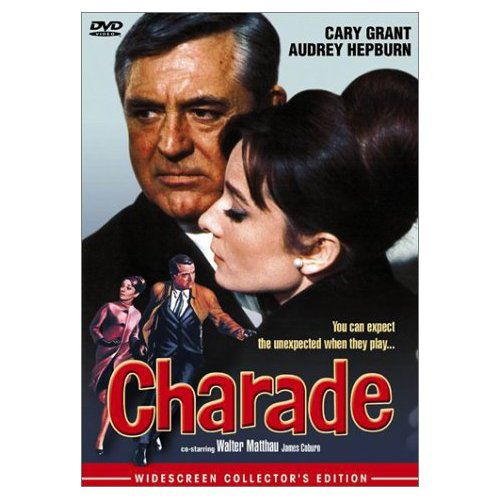Charade: French Alpine Tartiflette Casserole Recipe 🥁 🥁 🥁 🥁1/2
/Year Released: 1963
Directed by: Stanley Donen
Starring: Cary Grant, Audrey Hepburn, Walter Matthau
(PG, 114 min.)
Genre: Mystery and Thriller, Comedy
“Women make the best spies.” Audrey Hepburn as Reggie Lambert
“The best Hitchcock movie Hitchcock never made.” And no wonder. We have Hitchcock favorite Cary Grant with echoes of North by Northwest and To Catch a Thief. As well as ever elegant Audrey Hepburn, exquisitely beautiful and rivaling the tailored loveliness of Grace Kelly in Rear Window.
A beautiful widow tries to find her husband’s lost fortune while eluding killers who want it for themselves.
As in several Hitchcock films, we have not just one case of mistaken identity (North by Northwest), but several, including Cary Grant, who changes his name about as frequently as most of us change our passwords today.
Is he man about town and reluctant beau Peter Joshua, Alexander Dyle, brother of a dead man, Adam Canfield, a self-confessed thief, or Brian Cruikshank, a Treasury Department official?
***
The witty banter begins right away in the French Alps, with insults and ready lies as quick as parry and thrust.
Reggie Lambert: You're blocking my view.
Peter Joshua: Oh, uh, oh, uh, which view would you prefer?
Reggie Lambert: The one you're blocking.
Reggie Lambert: Well, wasn't it Shakespeare who said "When strangers do meet in far off lands they should e'er long see each other again?"
Peter Joshua: Shakespeare never said that.
Reggie Lambert: How do you know?
Peter Joshua: It's terrible. You just made it up.
Reggie Lambert: Oh well, it sounds right.
Peter Joshua: Do we know each other?
Reggie Lambert: Why, do you think we're going to?
Peter Joshua: I don't know. How would I know?
Reggie Lambert: Because I already know an awful lot of people, and until one of them dies I couldn't possibly meet anyone else.
The chemistry between the 2 leads is electric, making us wonder why this is the only film where Grant and Hepburn co-starred. Perhaps that is due the 25-year age difference which they bantered away with humor:
Reggie Lambert: Here it comes, the fatherly talk. You forget I'm already a widow.
Peter Joshua: Well, so was Juliet, at fifteen.
Reggie Lambert: I'm not fifteen.
Peter Joshua: Well, that's your trouble. You're too old for me.
However, given that Cary Grant married Dyan Cannon, 33 years his junior, 2 years after this film, it seems that age differences really didn’t matter to him.
Another way they handled the age difference was having Hepburn’s Reggie the lovelorn aggressor, with Grant the reluctant would be lover. She leans into him – he remains upright and stiff. He is distracted and on the phone when she smothers him with kisses, a chaste scene that sizzles so much more than the easy erotic episodes of today.
Grant is also the same marriage averse gentleman he was in To Catch a Thief, also reflected in his divorced status as Roger Thorndale in North by Northwest:
“Now you listen to me, I'm an advertising man, not a red herring. I've got a job, a secretary, a mother, two ex-wives and several bartenders that depend upon me, and I don't intend to disappoint them all by getting myself ‘slightly’ killed.” –Roger Thorndale
In Charade a Punch and Judy puppet show exhibits this same disdain for matrimony, although in his own life, Grant was married 5 times!
Reggie Lambert: [explaining a puppet show] The man and woman are married.
Peter Joshua: I can see that. They're batting each other over the head.
Audrey Hepburn shows the rebel spirit she first showcased in Roman Holiday (1953), a pampered princess escaping “rigid and oppressive royal etiquette,” as well as her free-spirited Holly Golightly in Breakfast at Tiffany’s, made the same year as Charade.
Telling Grant that women make the best spies, she goes full cloak and dagger – dark glasses and trench coat – in a comic take on tailing a suspect, where it is more than obvious that while women may make the best spies, Hepburn’s Reggie isn’t one of them.
This comic thriller also features the hulking 6’3” George Kennedy as a Jaws precursor, his appendage a hooked hand instead of those terrible teeth. It also gives us the initiable Walter Matthau as a CIA desk jockey – or is he?– also trying to corral the impetuous Reggie.
A delight with two film icons whose natural charm and elegance comes as easy as breathing for each. Not to miss. Or watch it again to brighten your day.
–Kathy Borich
🥁 🥁 🥁 🥁1/2
Trailer
Film-Loving Foodie
Our featured dish – no, I am not referring to the lovely Audrey Hepburn – is a wonderful recipe from the French Alps, where Audrey Hepburn and Gary Grant first meet. Strangely enough for a French food, it is really relatively uncomplicated.
A unique history
The comforting dish of tartiflette is not actually that old. In fact, it was invented in the 20th century and has its origins in the famous Reblochon cheese. This well-known cheese, made from the second milking of cows, has a particular creaminess, which is what makes it so appealing for a dish like tartiflette.
The Syndicat Interprofessionnel du Reblochon is said to have developed this recipe to boost sales of the cheese, but they deny any involvement.
However, the dish has its origins in an old traditional recipe called pêla, made with potatoes, onions and cheese. In the 20th century, cheese maturers in Savoie had too much Reblochon and were looking for a way to sell it. They brought the pêla back into fashion by replacing the original cheese with Reblochon … and tartiflette was born!
A restaurant owner in La Clusaz is said to have given the dish its name. The word “tartifle” in Savoyard dialect translates to potato. –Lindsay of Ovonetwork.com
French Alpine Tartiflette Casserole
About the purists who insist on the Reblochon cheese:
There are people who will tell you the only correct tartiflette is one made with Reblochon cheese. Pshaw! I say, that's just some clever marketing by none other than the consortium of Reblochon producers dedicated to selling the cheese. I say this as someone who has eaten "real" tartiflette, in France, made with Reblochon by farmers from the Savoie region (where Reblochon comes from), using their very own la ratte potatoes that they dug from the earth with their very own leathery, soil-stained fingers. Was it transcendent? Of course it was! But I've also eaten it made with yellow potatoes from the supermarket, and with a variety of funky, soft-rind cow's milk cheeses. And those were wonderful too. Don't let the Reblochon rule stop you, especially if you're in the United States where it currently can't be imported—you too can eat tartiflette using any number of similar soft-rind cheeses. I dare any of the purists to refuse a bite of non-Reblochon "tartiflette," or, if they deign to take one, to say it's not still glorious. –Danile Gritzer
Ingredients
· 2 1/4 pounds (1kg) Yukon Gold potatoes
· Kosher salt
· 3 fresh thyme sprigs
· 1/4 pound (115g) slab or thick-cut bacon, cut into 1/4-inch lardons
· 1 to 2 tablespoons (15 to 30g) unsalted butter, only if needed
· 2 medium (8-ounce; 225g) yellow onions, thinly sliced
· Freshly ground black pepper
· 1/2 cup (120ml) dry white wine
· 1/2 cup (120ml) heavy cream or crème fraîche
· 1 pound (450g) Reblochon-style soft-rind cheese (or any soft rind cow’s milk cheese such as Laughing Cow, feta, Brie, ricotta, cream cheese, Camembert, Chevre, Roquefort, and gorgonzola, and – of course – cottage cheese.)
Directions
1. Peel potatoes and cut into 1/2-inch thick rounds. In a large pot, cover potatoes with cold water. Season generously with salt, add thyme, and bring to a gentle simmer over medium heat. Cook at a bare simmer until potatoes are just tender and can be easily pierced with a paring knife, about 25 minutes. Discard thyme, drain potatoes, return to pot, and set aside.
2. Adjust oven rack to middle position and preheat oven to 350°F (175°C). In a 10-inch cast iron or stainless-steel skillet, heat bacon over medium-high heat until fat begins to render. Lower heat to medium and continue to cook, stirring occasionally, until fat is mostly rendered and bacon is cooked but not crisp, about 5 minutes. If there is excessive rendered fat, drain off all but 1/4 cup (60ml); conversely, if the bacon is lean and didn't release much fat, add 1 to 2 tablespoons (15 to 30g) butter. Add onions, season with salt and pepper, and cook, stirring frequently, until onions have softened but not browned, about 8 minutes.
3. Add white wine and cook, stirring, until wine has almost fully cooked off, 1 to 2 minutes. Scrape bacon-onion mixture into pot with potatoes and toss gently to thoroughly combine.
4. Scrape potato mixture back into cast-iron skillet or into a 3-quart (3L) baking dish. Add cream or crème fraîche (the latter is thicker, so you can dollop it around in that case).
5. Cut cheese into roughly 1/2-inch-thick slabs. You can do this by cutting the cheese wheels in half to make half-moons; halve wheels through the equator; or slice crosswise into thick planks. Arrange cheese on top of potatoes, rind side up. Set skillet or baking dish on top of a rimmed baking sheet and bake until the cheese is melted and bubbling and lightly browned on top, about 40 minutes.
6. Serve, scooping tartiflette from the skillet or baking dish onto individual serving plates.




















